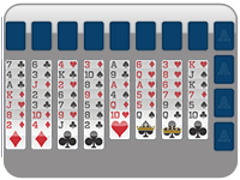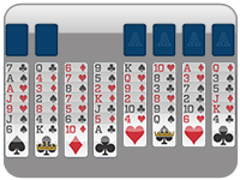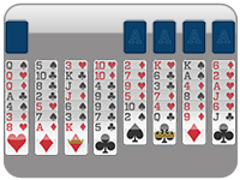Mastering the FreeCell Rules: A Beginner's Guide

If you've ever spent a long time using Windows or just browsing internet card games, you'll have encountered FreeCell at some point. But do you know what it really is? Could you explain how it works to a friend?
Don't worry if you can't. That's why we've written this guide. It explains what FreeCell is, how to set it up, getting to grips with the basics, and strategies you can use to win more predictably.
Here's what you need to know:
What is FreeCell: A Quick Overview
FreeCell is a single-player solitaire-like card game but with a twist: it's set up to make it easier for players to win.
In standard two-deck solitaire, the odds of receiving a hand that enables a win is around 35% (which isn't great). However, these odds drop even further as you add new decks or suits, falling to less than 1% under some spider solitaire rules.
FreeCell changes all of this. It has 8 cascades (with cards dealt face up), 4 free cell spaces that can hold one card temporarily, and 4 foundations, like in regular solitaire. It's the additional free cell spaces that are critical for making the game winnable (and where it gets its name).
How to Set Up Your FreeCell Game
If you play FreeCell online, you won't have to do any setup at all. Software will do everything for you.
However, you can also do it by hand. Here's how to get started:
Shuffle The Deck
The first step is to shuffle the deck. Make sure you randomize all 52 cards (minus the jokers).
Deal The Cascades
The next step is to deal the cascades (sometimes called the "tableau columns"). In FreeCell, you add 7 cards to the first four columns and 6 cards to the last four. Then, you leave the final card on each column upward-facing so you can see where to place dealt cards.
Set Up The Play Area
After that, you need to set up the play area. By convention, you leave space for 4 free cells in the top left, and 4 foundation piles in the top right.
Once you have all that set up, you're essentially ready to go. All you need to do is start dealing to unlock cards buried in the cascade, and you're off to the races.
Mastering FreeCell: Basic Rules

So, what basic rules do you need to know if you want to play a game of FreeCell?
Well, one option is to just click and figure it out yourself. But another is to go into each game using the knowledge we outline below.
In FreeCell, all cards are immediately visible (unlike solitaire). This feature makes the game more winnable. All you have to do is make allowable moves from one pile to another, according to the rules.
- Moving cards to a cascade. The card you move should be one rank lower and the opposite color (just like in solitaire). For example, you can place a six of clubs on top of a seven of diamonds.
- Moving cards to a free cell. You can only put one card in each free cell up to a maximum of four. You can also move them in and out of their spaces according to the other movement rules.
- Moving cards to the foundation. You can only move cards to the foundation in ascending order if they are the next in the suit, starting with the aces. For example, if you have the ace of hearts in a foundation slot, the two of hearts is the only card you can add to the space.
- Moving cards to empty cascade slots. You can move entire ordered sequences to empty cascades if you have any.
- Moving multiple cards. You can move multiple cards with valid descending and color-alternating sequences between cascades to free up additional cards if needed. However, some FreeCell games impose limits on how many cards you can move at once, depending on the number of empty free cells you have.
To win the game, you must fill up the 4 foundations for each suit in the proper order (Ace, 2, 3, 4, 5, 6, 7, 8, 9, 10, Jack, Queen, King).
Strategies for Moving Cards in FreeCell
Of course, FreeCell is more complicated than it first appears. The rules are simple, but how you respond to them matters a lot.
In this section, we explore some of the top strategies for moving cards in FreeCell. By the end of it, you should better understand what you need to do.
Try To Empty An Entire Cascade
Your first job is to find a way to empty at least one cascade. If you have a free slot, larger moves that generate alternating, descending sequences become easier.
Most experienced players try to do this in 10 moves or less. Once the column is free, it makes the second half of the game much more straightforward.
Avoid Wasting Free Cells
You should also use strategies to avoid wasting free cells (the holding areas for up to 4 cards). You need these to complete games quickly.
Therefore, always see if you can move cards into a free cascade slot, or between cascades. If you do this, it will lubricate the entire board and enable you to take action (by removing a card) when you really are stuck.
Figure Out Card Priorities
Practicing card prioritization in games of FreeCell is also a good idea. Not all cards are created equal.
For example, when you expose aces, try to place them on foundation spots immediately. This enables you to begin building final decks from whatever cards are available. Once you have aces in place, it gives you more options for where to put cards.
Meanwhile, low cards in the wrong column should be freed to build on higher cards. If you don't build these up quickly, they can block you from creating sequences and force you to use more free cells.
If you have kings free, put them in empty cascade columns. Then, you can add queens, jacks and so on down the list.
Lastly, if you have free cells, use them sparingly, or for mid-rank cards blocking set formation. Move them out of the tableau temporarily before putting them back in.
Think In Chains
Training yourself to think in chains is another good idea. For example, let's say you have a chain but you also have some cards on the foundation pile. Sometimes, it's okay to break that chain if it means you can put away some of the cards. Then, you can rebuild a new chain using cards from other suits elsewhere.
Think Three Moves Ahead
Lastly, always ensure you think three or more moves ahead. FreeCell is winnable from most positions, but you can get to the finishing line faster if you plan.
You can "undo" in FreeCell apps, but it is more challenging when using physical cards. Therefore, simulate in your mind what's going to happen next and move forward based on that.
Understanding FreeCell Solitaire Scoring
Microsoft developed the FreeCell scoring system to keep track of your progress. The idea was to make solitaire more competitive. Instead of just trying to complete foundation suits, you're also playing against yourself.
Here's how the scoring system usually works:
- Card to foundation: +10
- Card from free cell to foundation: +10
- Card to free cell: -15
- Card from free cell to cascade: -15
- Time-based winning bonuses
The most you could score under this system was 2020 (if you completed the game in under 100 seconds on Windows XP). To get this score, you had to put all the cards on the foundation (52x10=520) and get the 1500-point time bonus with no penalties for using free cells.
Interestingly, many new apps don't penalize the use of free cells. (They're there for a reason, after all!) Instead, each provider now has their own rules.
For example, some FreeCell games will penalize you for each additional move you make (since completing the game in fewer moves is harder and indicates more planning). Others cap winning points or reward card placement streaks with escalating bonuses.
However, most games will not penalize you if you use the undo feature. Therefore, if you make a really poor decision, you can go back.
Challenges and Tips for FreeCell Enthusiasts

So, if you're a FreeCell enthusiast, what challenges can you pursue?
- Complete the "impossible game." Microsoft actually offers a version of FreeCell with no free cells and all aces trapped under the wrong suits. The company believes it is impossible to complete, but perhaps that's because you haven't tried it yet!
- Do a speedrun. You could also try to complete FreeCell in the minimum amount of time. Most records are around 30 seconds (depending on the version), with anything under 60 seconds already elite level. (You can't undo and you can only use a mouse).
As for tips, how can you become a better FreeCell player and really dominate the competition (and any online free versions of the game you play)?
- Use aces and 2s to form the foundations early on so you can keep adding more cards opportunistically as they arise in the right positions.
- Don't move the same card twice if you can help it. (It wastes time and can lead to penalties in some game versions).
- Try to group suits with each other early on. If you can do this well, it makes it easier to transfer them to the foundations later.
- Don't trap high-value cards (over 8) with lower cards of the opposite color. It's unlikely that you'll be able to turn them into sequences without relying on free cells.
- Learn "supermove" math: The number of cards you can move from one cascade to another varies with the number of free cells you have available.
- Only break a sequence to place a foundation card. Removing cards from the cascades is usually beneficial.
Playing FreeCell: From Beginner to Expert
As you practice FreeCell, you'll feel less like a beginner and more like an expert. First, you'll get to grips with the rules, and then you will start seeing deeper patterns.
Most of the time, you won't win your first few games. Therefore, see this step as a learning curve and an opportunity to witness what you can get wrong.
As you progress to the intermediate stage, you'll begin winning more than 70% to 90% of games. Here's where you'll want to begin implementing all the strategies and tips we've discussed in this guide. For example, you'll need to scan for aces and move them to the foundations while splitting sequences to remove blockers (like 9s or 10s).
At the expert stage, you should win most, if not all, games you start. You should also be looking to complete games faster and more intuitively with fewer mistakes, perhaps in less than 100 seconds.
FAQs About FreeCell Rules and Gameplay
Is It Possible To Choose A Starting Deal?
Yes, some versions of FreeCell let you choose a starting deal (one that's proven to let you finish the game). These are often labeled with numbers and you can type the game you want into a console.
Where do the free cells and foundations go?
Free cells go in the top left of the game board. Foundations go in the top right. The cascade is below both of them and in the middle of the two.
How many cards are there in a FreeCell deck?
FreeCell uses a standard deck of 52 cards without jokers.
How many cards can you put in a free cell?
You can only put one card at a time in a free cell. You can't stack them, like you can in the cascade or on the foundation piles.
Should I aim to fill all free cells?
Ideally, you'd like to avoid using any free cells at all. If you do use them, do so sparingly. Once they're full, you can't use them for anything else.
Freecell Games
More Solitaire Games
More Games
247 Freecell News
Disclaimer
DISCLAIMER: The games on this website are using PLAY (fake) money. No payouts will be awarded, there are no "winnings", as all games represented by 247 Games LLC are free to play. Play strictly for fun.



























